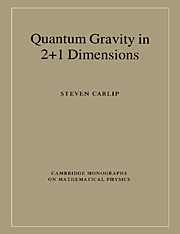
-
Select format
-
- Publisher:
- Cambridge University Press
- Publication date:
- December 2009
- July 1998
- ISBN:
- 9780511564192
- 9780521545884
- Dimensions:
- Weight & Pages:
- Dimensions:
- (247 x 174 mm)
- Weight & Pages:
- 0.53kg, 292 Pages
You may already have access via personal or institutional login
Book description
This timely volume provides a broad survey of (2+1)-dimensional quantum gravity. It emphasises the 'quantum cosmology' of closed universes and the quantum mechanics of the (2+1)-dimensional black hole. It compares and contrasts a variety of approaches, and examines what they imply for a realistic theory of quantum gravity. General relativity in three spacetime dimensions has become a popular arena in which to explore the ramifications of quantum gravity. As a diffeomorphism-invariant theory of spacetime structure, this model shares many of the conceptual problems of realistic quantum gravity. But it is also simple enough that many programs of quantization can be carried out explicitly. After analysing the space of classical solutions, this book introduces some fifteen approaches to quantum gravity - from canonical quantization in York's 'extrinsic time' to Chern-Simons quantization, from the loop representation to covariant path integration to lattice methods. Relationships among quantizations are explored, as well as implications for such issues as topology change and the 'problem of time'. This book is an invaluable resource for all graduate students and researchers working in quantum gravity.
Reviews
‘For both experts and non-experts, this is an eminently readable and useful book.’
Renate Loll Source: General Relativity and Gravitation
Contents
Metrics
Altmetric attention score
Full text views
Full text views help Loading metrics...
Loading metrics...
* Views captured on Cambridge Core between #date#. This data will be updated every 24 hours.
Usage data cannot currently be displayed.
Accessibility standard: Unknown
Why this information is here
This section outlines the accessibility features of this content - including support for screen readers, full keyboard navigation and high-contrast display options. This may not be relevant for you.
Accessibility Information
Accessibility compliance for the PDF of this book is currently unknown and may be updated in the future.


